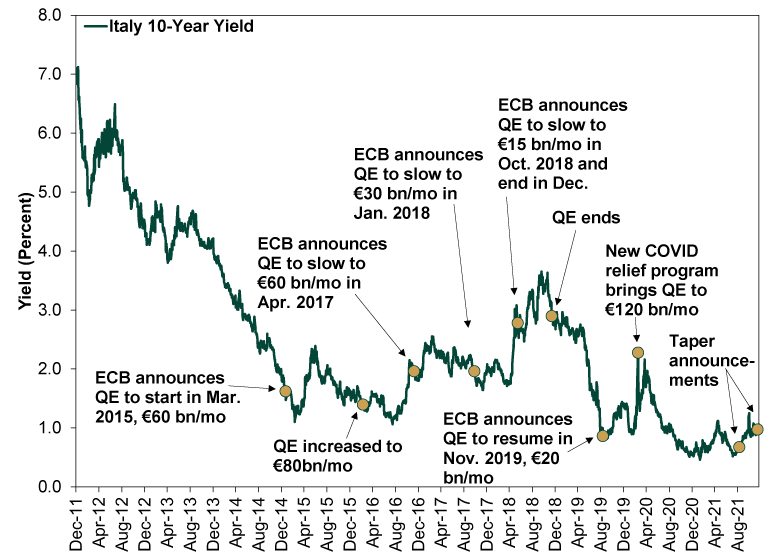Personal Wealth Management / Economics
Italy’s Debt Still Looks Like a False Threat
While the country’s debt load is up, it remains more affordable than ever.
If we had to make a list of habits investors can’t shake, fighting the last war would be near the top—whenever a big event roils markets, people look out for a repeat for years afterward. So it is today, with Italian debt fears storming back into headlines. Due to the one-two punch of last year’s steep economic contraction and the borrowing binge to fund relief measures, Italy’s debt-to-GDP ratio is jumping again—from 134.3% at 2019’s end to 155.2% as of Q3 2021.[i] Now that the ECB is poised to close its pandemic-related “emergency” quantitative easing (QE) and reduce monthly bond purchases to €40 billion next April, an old worry is back: Italian debt. Without the ECB buying massive amounts of Italian bonds, many fear the country’s debt costs will surely soar, delivering the long-awaited debt crisis—big trouble for Italy’s economy and stocks. In our view, a quick trip in the way-back machine debunks this handily.
As Exhibit 1 makes abundantly clear, Italy’s bond yields don’t depend on ECB QE. For one, the first QE program didn’t even start until March 2015, by which time Italy’s 10-year yield had fallen from north of 7% in 2011 to just 1.33%.[ii] Yields actually rose for a spell after bond purchases began, but they were back below 1.5% by the time the ECB increased its monthly asset purchases from €60 billion to €80 billion in March 2016. After the ECB’s December 2016 announcement it would slow bond buying to €60 billion monthly the following April (the bank’s first non-taper taper), Italy’s 10-year yield moved mostly sideways for almost a year and a half. It wiggled higher as the program neared its December 2018 end, but then it plunged below 1.0% in September 2019. That is when the ECB announced it would resurrect QE in November—and yields rose. In our view, there is just no discernible relationship here.
Exhibit 1: Italian Bond Yields Seemingly Ignored QE

Source: FactSet and European Central Bank, as of 12/22/2021. Italy 10-Year Benchmark Government Bond Yield, 12/31/2011 – 12/21/2021.
While credit risk does influence individual countries’ bond yields, developed-world yields are highly correlated globally. Italy’s wiggles over the past several years have largely echoed global moves, and the ECB’s recent moves to taper QE haven’t changed that. Moreover, markets are forward-looking, and the ECB’s plans are well known. If markets thought Italian debt were a material risk, we would likely see it in Italian yields relative to US Treasurys. Italy’s borrowing costs should far exceed America’s as investors sought a higher premium for the higher risk. But that isn’t the case: Italy’s 10-year bond trades about 40 basis points below the US’s.[iii] In our view, if there is a better sign that markets have priced in Italy’s debt and are signaling that it isn’t a problem, it would be hard to find.
Now, markets can be quite inefficient in the short term, but in this case, we think they are correctly taking a rational longer-term view. Italy’s big debt load isn’t due at once. It matures over time, and the government has no trouble replacing retiring bonds with new ones. That leaves interest payments—the cost of servicing that debt—as the swing factor. As Exhibit 2 shows, even though Italy’s debt is up, its debt service costs are down thanks to those several years of low rates shown in Exhibit 1. That enabled the country to refinance its debt stock at lower and lower rates, easing the annual burden on Italy’s treasury even as the amount of debt outstanding rose. Interest payments finished September at just 11.4% of tax revenues over the prior 12 months—the lowest on record.
Exhibit 2: Italy’s Debt Is More Affordable Than Ever

Source: FactSet, as of 12/22/2021. Italian net government debt interest payments divided by tax revenues, trailing 12 months, 12/31/1980 – 9/30/2021.
Italy’s debt service costs topped 40% of tax revenues for much of the 1990s, when central banks’ buying long-term bonds was unheard of. If the country didn’t have a debt crisis then, that suggests it would take much, much more than a slight move higher in long rates for real trouble to arrive. Rates would likely have to soar to nosebleed levels—far from where they are today. Then, crucially, they would have to remain there for eons. Anything is possible in the long run, but in the timeframe markets care about—the next 3 – 30 months—we think it is exceedingly unlikely. That doesn’t preclude some short-term wiggles—bond markets are volatile, too—but it does argue against a sudden, massive jump in Italian borrowing costs, in our view.
If you would like to contact the editors responsible for this article, please message MarketMinder directly.
*The content contained in this article represents only the opinions and viewpoints of the Fisher Investments editorial staff.
Get a weekly roundup of our market insights
Sign up for our weekly e-mail newsletter.

See Our Investment Guides
The world of investing can seem like a giant maze. Fisher Investments has developed several informational and educational guides tackling a variety of investing topics.





